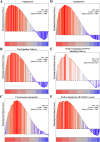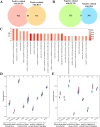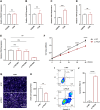Polycystic ovarian syndrome (PCOS) and recurrent spontaneous abortion (RSA) are associated with the PI3K-AKT pathway activation
- PMID: 39253602
- PMCID: PMC11382649
- DOI: 10.7717/peerj.17950
Polycystic ovarian syndrome (PCOS) and recurrent spontaneous abortion (RSA) are associated with the PI3K-AKT pathway activation
Abstract
Aims: We aimed to elucidate the mechanism leading to polycystic ovarian syndrome (PCOS) and recurrent spontaneous abortion (RSA).
Background: PCOS is an endocrine disorder. Patients with RSA also have a high incidence rate of PCOS, implying that PCOS and RSA may share the same pathological mechanism.
Objective: The single-cell RNA-seq datasets of PCOS (GSE168404 and GSE193123) and RSA GSE113790 and GSE178535) were downloaded from the Gene Expression Omnibus (GEO) database.
Methods: Datasets of PSCO and RSA patients were retrieved from the Gene Expression Omnibus (GEO) database. The "WGCNA" package was used to determine the module eigengenes associated with the PCOS and RSA phenotypes and the gene functions were analyzed using the "DAVID" database. The GSEA analysis was performed in "clusterProfiler" package, and key genes in the activated pathways were identified using the Kyoto Encyclopedia of Genes and Genomes (KEGG) analysis. Real-time quantitative PCR (RT-qPCR) was conducted to determine the mRNA level. Cell viability and apoptosis were measured by cell counting kit-8 (CCK-8) and flow cytometry, respectively.
Results: The modules related to PCOS and RSA were sectioned by weighted gene co-expression network analysis (WGCNA) and positive correlation modules of PCOS and RSA were all enriched in angiogenesis and Wnt pathways. The GSEA further revealed that these biological processes of angiogenesis, Wnt and regulation of cell cycle were significantly positively correlated with the PCOS and RSA phenotypes. The intersection of the positive correlation modules of PCOS and RSA contained 80 key genes, which were mainly enriched in kinase-related signal pathways and were significant high-expressed in the disease samples. Subsequently, visualization of these genes including PDGFC, GHR, PRLR and ITGA3 showed that these genes were associated with the PI3K-AKT signal pathway. Moreover, the experimental results showed that PRLR had a higher expression in KGN cells, and that knocking PRLR down suppressed cell viability and promoted apoptosis of KGN cells.
Conclusion: This study revealed the common pathological mechanisms between PCOS and RSA and explored the role of the PI3K-AKT signaling pathway in the two diseases, providing a new direction for the clinical treatment of PCOS and RSA.
Keywords: GSEA; GSEA analysis; PI3K-AKT signaling pathway; Polycystic Ovary Syndrome (PCOS); Recurrent spontaneous abortion (RSA); “WGCNA”.
© 2024 Lin et al.
Conflict of interest statement
The authors declare that they have no competing interests.
Figures







Similar articles
-
Shared diagnostic genes and potential mechanisms between polycystic ovary syndrome and recurrent miscarriage revealed by integrated transcriptomics analysis and machine learning.Front Endocrinol (Lausanne). 2024 Sep 27;15:1335106. doi: 10.3389/fendo.2024.1335106. eCollection 2024. Front Endocrinol (Lausanne). 2024. PMID: 39398336 Free PMC article.
-
Upregulation of PD-L1 contributes to improving the apoptosis of granulosa cells via the PI3K/AKT pathway in PCOS.J Assist Reprod Genet. 2025 Feb;42(2):611-625. doi: 10.1007/s10815-024-03327-y. Epub 2024 Dec 11. J Assist Reprod Genet. 2025. PMID: 39663282 Free PMC article.
-
High levels of fatty acid-binding protein 5 excessively enhances fatty acid synthesis and proliferation of granulosa cells in polycystic ovary syndrome.J Ovarian Res. 2024 Feb 19;17(1):44. doi: 10.1186/s13048-024-01368-6. J Ovarian Res. 2024. Retraction in: J Ovarian Res. 2025 Jun 16;18(1):132. doi: 10.1186/s13048-025-01713-3. PMID: 38373971 Free PMC article. Retracted.
-
Insulin resistance, autophagy and apoptosis in patients with polycystic ovary syndrome: Association with PI3K signaling pathway.Front Endocrinol (Lausanne). 2022 Dec 16;13:1091147. doi: 10.3389/fendo.2022.1091147. eCollection 2022. Front Endocrinol (Lausanne). 2022. PMID: 36589825 Free PMC article. Review.
-
Apoptosis in polycystic ovary syndrome: Mechanisms and therapeutic implications.Life Sci. 2025 Feb 15;363:123394. doi: 10.1016/j.lfs.2025.123394. Epub 2025 Jan 12. Life Sci. 2025. PMID: 39809382 Review.
Cited by
-
Identification of epidemiological risk factors associated with missed abortion in polycystic ovary syndrome: a retrospective analysis.BMC Pregnancy Childbirth. 2025 Aug 12;25(1):842. doi: 10.1186/s12884-025-07975-5. BMC Pregnancy Childbirth. 2025. PMID: 40796819 Free PMC article.
References
-
- Alkhuriji AF, Al Omar SY, Babay ZA, El-Khadragy MF, Mansour LA, Alharbi WG, Khalil MI. Association of IL-1β, IL-6, TNF-α, and TGFβ1 gene polymorphisms with recurrent spontaneous abortion in polycystic ovary syndrome. Disease Markers. 2020;2020(3):6076274. doi: 10.1155/2020/6076274. - DOI - PMC - PubMed
-
- Bender Atik R, Christiansen OB, Elson J, Kolte AM, Lewis S, Middeldorp S, McHeik S, Peramo B, Quenby S, Nielsen HS, van der Hoorn ML, Vermeulen N, Goddijn M. ESHRE guideline: recurrent pregnancy loss: an update in 2022. Human Reproduction Open. 2023;2023(1):hoad002. doi: 10.1093/hropen/hoad002. - DOI - PMC - PubMed
MeSH terms
Substances
LinkOut - more resources
Full Text Sources
Medical

